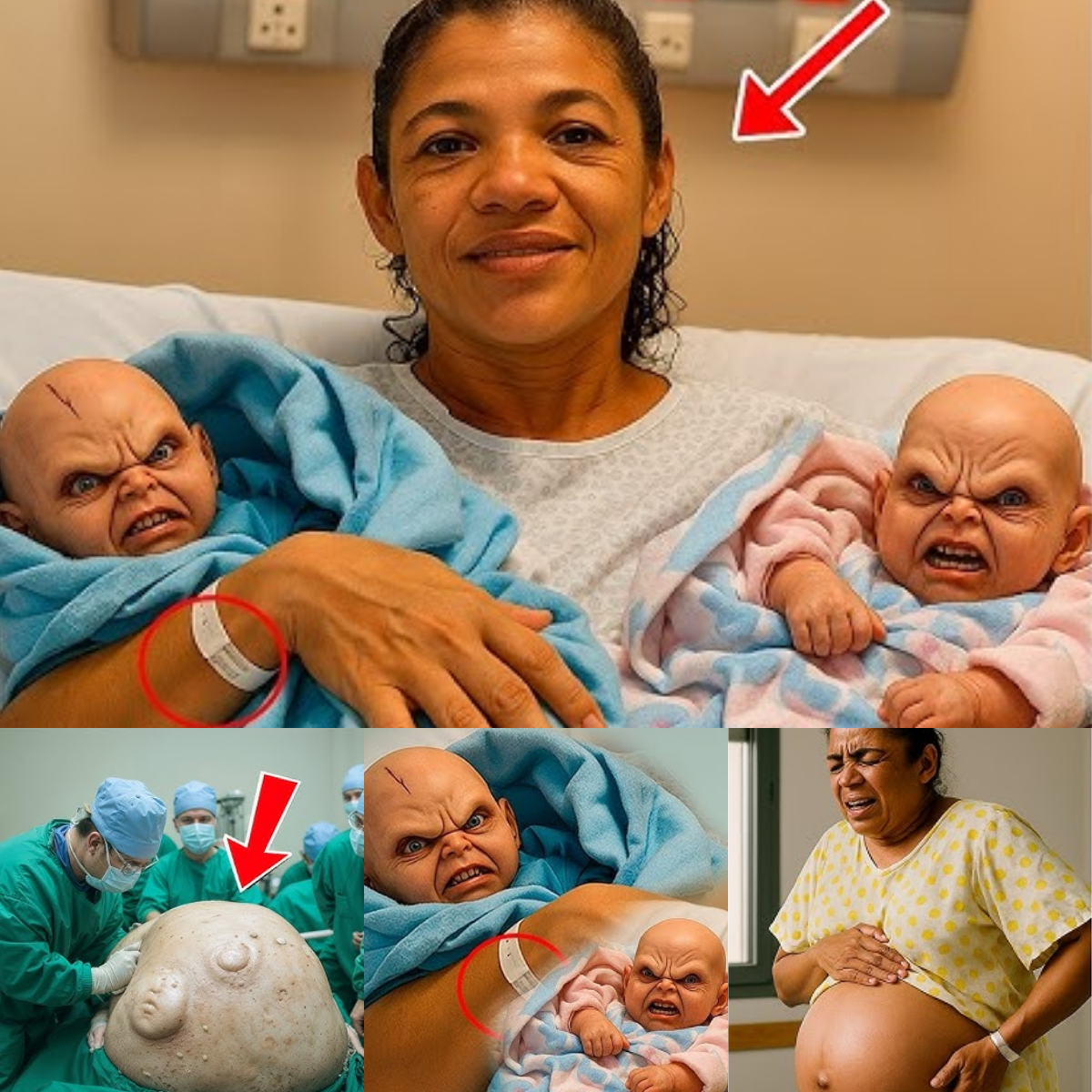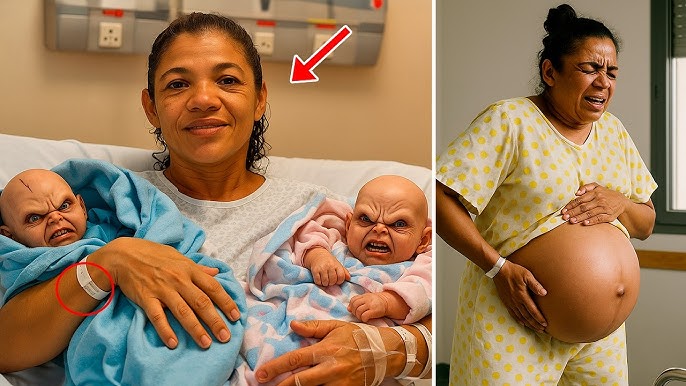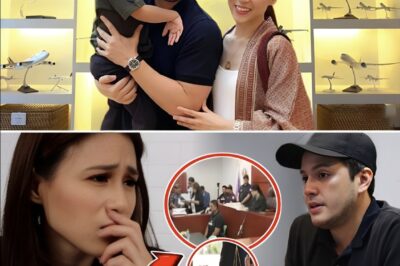The Delivery That No One Could Explain
The maternity ward of St. Helena Hospital in Chicago had seen its share of strange nights — premature twins, emergency C-sections, even a baby born during a blizzard power outage.
But nothing — absolutely nothing — could have prepared Dr. Lauren King and her team for what they were about to witness on that freezing February morning.
At 2:47 a.m., the ambulance doors burst open. Paramedics wheeled in a heavily pregnant woman, pale and shaking, clutching her swollen belly.
Her name: Amelia Grant, age 32.
“She kept saying, ‘My babies… they’re not moving anymore.’” one nurse later recalled. “She was terrified — but not in the way normal mothers are before delivery. It was like she was guarding a secret.”

Within minutes, Amelia was rushed into the delivery room. Her blood pressure was unstable, her pulse racing. The doctors prepped for an emergency C-section.
When the incision was made, silence filled the room.
And then came the unthinkable.
What the surgeons pulled from her womb… were not human babies.
They were two lifelike silicone reborn dolls, complete with hand-painted veins, glass eyes, and tiny hospital bracelets with names written in perfect cursive:
“Ethan” and “Ella.”
The Room Fell Silent
“At first, we thought it was some kind of sick prank,” said Dr. King in her later statement. “But then we realized the woman truly believed they were real.”
Amelia sobbed uncontrollably as she saw the dolls. She reached out, whispering, “Don’t take them away… please, they’re my babies.”
No one in the room knew what to do.

How could a woman appear pregnant — showing all the symptoms, the belly growth, even fetal movements — and yet deliver… dolls?
The hospital immediately called in the psychiatric team, along with law enforcement, fearing possible criminal intent. But what they discovered next changed the entire narrative — from bizarre to heart-shattering.
The Investigation Begins
Amelia’s medical records showed she had been undergoing prenatal check-ups at a small private clinic run by a Dr. Theodore Lanning — a retired obstetrician. But when authorities visited the address, the clinic had been closed for months.
Its files were gone.
Her ultrasound photos were examined next — and shockingly, they were forgeries, digitally altered to show developing fetuses. The signatures of approval from doctors were fake.
So what happened?
How did a seemingly healthy woman end up in a full-term “pregnancy” with two reborn dolls inside her womb?
The Psychological Mystery

Forensic psychiatrists soon pieced together the tragic truth. Amelia had suffered a psychotic break caused by postpartum trauma and grief — but with a horrifying twist.
Three years earlier, she had given birth to twins — a boy and a girl — who both died during a house fire caused by faulty wiring. The loss destroyed her marriage, her mental health, and her entire sense of self.
“She stopped living after that night,” said her neighbor, Mrs. Caldwell. “She kept the nursery exactly as it was. She’d sit there for hours, talking to the empty cribs.”
Eventually, Amelia found solace in an online “reborn doll” community — where artists craft hyper-realistic baby dolls for grieving parents. They looked identical to real infants — with weighted bodies, rooted hair, and heartbeat simulators.
Her two dolls, Ethan and Ella, were custom made to resemble her deceased children.
But Amelia’s grief ran so deep that her mind crossed a dangerous line. Her body, convinced by the delusion, began to mimic pregnancy symptoms — known medically as pseudocyesis, or false pregnancy.
The Desperate Decision
Over the months, Amelia’s abdomen began to swell. Hormonal changes triggered by her mind caused weight gain, milk production, and even morning sickness.
Her neighbors celebrated her “miracle pregnancy.” She smiled, accepting gifts and congratulations.
But when her “due date” approached, panic set in. She feared people would discover there were no babies.
So she made a desperate, devastating decision.
Using tutorials she found online and crude surgical tools she purchased on the dark web, Amelia attempted a self-induced C-section, intending to “deliver” her reborn dolls — believing that only then would her children “become real.”
She nearly bled to death before the neighbors heard her screams and called 911.
The Doctor’s Tears
For Dr. King and her team, the event was not just a medical anomaly — it was a human tragedy.
“We see grief every day,” she told the Chicago Tribune, “but this was something else. She wasn’t crazy. She was broken.”
Hospital records later revealed Amelia had been prescribed antidepressants but stopped taking them months before. She had refused counseling, insisting she was “fine.”
When Dr. King visited her in recovery, Amelia was holding the reborn dolls, softly singing a lullaby. She looked up and asked, “Can I take them home?”
The doctor couldn’t answer.
Public Outcry and Ethical Debate
Within 48 hours, the story leaked online. Headlines exploded:
“Woman Gives Birth to Dolls!”
“Psychosis or Miracle? Internet Divided Over Reborn Mom”
“Medical Mystery in Chicago Leaves Doctors Speechless.”
While many mocked her, others defended her fiercely. Support groups for grieving mothers flooded social media with messages of empathy. Psychologists urged compassion, warning against the viral ridicule.
“This woman is not a spectacle,” wrote Dr. Miriam Fields, a trauma specialist. “She is proof that grief, when untreated, becomes a sickness that blurs the line between body and mind.”
The case reignited global discussions about the ethics of the “reborn doll” industry — which some argue helps grieving parents heal, while others say it deepens delusion.
A Visit from Her Husband
After the incident, Amelia’s estranged husband, Daniel Grant, returned for the first time in years. Their last conversation had ended in shouting and shattered picture frames.
When he saw her lying in the hospital bed, cradling the two dolls, he broke down.
“She looked at him and said, ‘They have your eyes, Danny.’” a nurse recounted.
Daniel later admitted he had ignored her pain for too long. “I thought she’d move on. I didn’t realize she was moving deeper into the fire.”
He agreed to help her get treatment and admitted her to a long-term psychiatric rehabilitation center outside Chicago.
Inside the Recovery
For months, Amelia lived in a quiet countryside facility specializing in trauma therapy. She painted, gardened, and, under supervision, was allowed limited contact with her dolls — gradually learning to separate her memories from her delusions.
Her psychiatrist, Dr. Fields, used art therapy to help her express her grief safely. “We didn’t take the dolls away immediately,” she said. “That would’ve been cruelty disguised as treatment. Instead, we helped her rewrite their story — from ‘my babies are alive’ to ‘my babies are remembered.’”
One day, Amelia brought two blank canvases into the therapy room. On them, she painted her twins — not as reborn dolls, but as angels standing beside her. It was the first time she called them gone instead of sleeping.
That was the turning point.
Six Months Later: A Second Chance
Half a year after the night that shocked the world, Amelia was released under care supervision. She moved into a quiet home by Lake Michigan, working part-time at a community art center for children.
When a reporter asked if she still kept the dolls, she smiled sadly. “They’re in a box now,” she said. “Not because I don’t love them — but because I finally understand love doesn’t need them to breathe.”
The hospital staff who once performed that unthinkable delivery still remember her. Some say they learned more about the human heart that night than in years of medicine.
A Story That Changed Medicine
The “Reborn Twins Case,” as it came to be known in medical circles, is now studied in universities around the world. It highlights the rare intersection of psychology, physiology, and grief — a reminder that the human body can obey the mind’s illusions with terrifying precision.
But for Dr. King, it’s something simpler.
“When people ask me what I remember most,” she says, “it’s not the dolls. It’s her face — that moment she realized they would never cry. That silence was louder than any scream.”
Epilogue: The Lesson Left Behind
Today, Amelia’s story is used by grief counselors to teach compassion. She has since spoken — anonymously — through a therapist’s podcast, hoping her experience might help others.
Her words are haunting yet healing:
“The mind can lie, the body can follow, but the heart… the heart always knows the truth. I didn’t need to give birth to hold my children again. I just needed to let them go.”
Final Reflection
What began as a shocking headline — “Woman Gives Birth to Reborn Dolls” — turned into something deeper: a portrait of how love and loss can twist reality itself.
Behind the viral story was not madness, but a mother’s devotion that refused to die — until it finally learned to find peace.
And somewhere, on a quiet lakeshore in Chicago, a woman paints two tiny figures with halos of light — the children who never left her heart, even when the world thought she’d lost her mind.
News
Siyam na Taon Nagwakas: Annulment nina Toni Gonzaga at Paul Soriano, Aprubado na ng Korte! Isyu ng Love Child at Pagtataksil, Binasag ang Pangarap ng Pamilya
Sa isang balita na nagpabigla at nagpaluha sa milyun-milyong Pilipino, pormal nang winakasan ng Korte ang halos isang dekadang pagsasama…
‘Kami-Kami Lang Talaga’: Rochelle Pangilinan Reveals Sexbomb Members Self-Funded Reunion Concert After Producer Rejection, Leading to Historic Sellout
Ang matagumpay na pagbabalik ng Sexbomb Girls sa entablado ng konsiyerto ay isang kultural na penomeno na nangibabaw sa social…
‘Walang Awa Grabe!’: Lumalalim ang Trahedya sa Pinansyal Nang Umano’y Inubos ni Lakam, Kapatid ni Kim Chiu, ang Ipon sa Bangko ni Daddy William
Ang salaysay ng kahirapan sa pananalapi at pagtataksil sa pamilya sa loob ng angkan ng Chiu, na nakasentro sa umano’y…
Kimpau Rumors Uminit: Kim Chiu at Paulo Avelino, Tinutukan ang “3 Years Na” Moment sa ABS-CBN Christmas Special
Nagkakagulo ang social media matapos kumalat ang usap-usapang “3 years na” raw sina Kim Chiu at Paulo Avelino—isang pahayag na…
Confirmed! Sikat na Aktres, Balik-Kapamilya sa Bagong Serye Matapos ang Matagal na Pagliban
Kumpirmado na ang matagal nang hinihintay ng maraming manonood: isang kilalang aktres ang muling magbabalik sa Kapamilya network para sa…
Surprising Truth? Jinkee Pacquiao’s Assistant Rebuts Rumors That Eman Was Abandoned by Manny Since Childhood
(From left) Jinkee Pacquiao, Manny Pacquiao, and Eman Bacosa Pacquiao. Images: Instagram/@jinkeepacquiao, @emanbacosapacquiao A personal assistant of Jinkee Pacquiao defended her and…
End of content
No more pages to load












